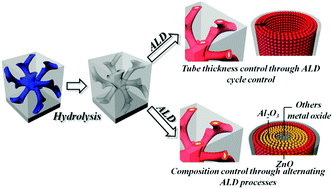Nanoporous gyroid metal oxides with controlled thickness and composition by atomic layer deposition from block copolymer templates†
Abstract
Herein, we aim to suggest an approach for the fabrication of nanoporous gyroid metal oxides with well-controlled tubular thickness and composition as well as film thickness by templated atomic layer deposition (ALD). The dip-coating method is used to prepare gyroid polystyrene-block-poly(L-lactide) (PS–PLLA) thin films with uniform film-thickness on the micrometer scale. Polymers with gyroid nanochannels can be obtained by hydrolysis of PLLA blocks in the PS–PLLA film, which served as a template for ALD. Templated ALD is carried out to fabricate PS/ZnO gyroid nanohybrids. After removal of the PS matrix, nanoporous gyroid ZnO can be obtained. Controlled diffusion length (i.e., film thickness) for the growth of the nanoporous ZnO can be attained by tuning the exposure time of precursor gas whereas controlled tubular thickness can be achieved through the control of ALD cycles. Moreover, alternating reaction processes to introduce various precursor gases for templated ALD were carried out for the formation of core–shell metal oxide alloys, e.g. Al2O3@ZnO, demonstrating the feasibility to create nanoporous gyroid networks with controlled composition. As a result, micrometer-thick nanoporous gyroid alloys with large specific surface area and high porosity as well as superior mechanical properties can be successfully fabricated.


 Please wait while we load your content...
Please wait while we load your content...